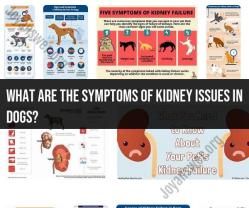How to spot Lyme disease symptoms in dogs?
Lyme disease in dogs is caused by the bacterium Borrelia burgdorferi, which is transmitted through the bite of infected black-legged ticks (Ixodes scapularis or Ixodes pacificus). Early detection and treatment of Lyme disease in dogs are essential to prevent more severe complications. Here are some tips on how to spot Lyme disease symptoms in dogs:
Lameness or Joint Pain:
- One of the hallmark symptoms of Lyme disease in dogs is lameness or limping, which can shift from one leg to another.
- The lameness may appear suddenly and may be intermittent, causing the dog to seem fine at times and then lame at other times.
- Dogs may show signs of joint pain, such as stiffness or reluctance to move.
Fever:
- Lyme disease can cause a fever in dogs. Check your dog's body temperature using a rectal thermometer. A normal temperature for dogs is around 101 to 102.5 degrees Fahrenheit (38.3 to 39.2 degrees Celsius).
Lethargy and Fatigue:
- Infected dogs may become lethargic and seem less active or enthusiastic than usual.
Loss of Appetite:
- A decreased appetite or refusal to eat can be a sign of Lyme disease in dogs.
Swollen Lymph Nodes:
- Enlarged lymph nodes, especially around the neck area, may be noticeable in some infected dogs.
Difficulty Breathing:
- In rare cases, Lyme disease can lead to cardiac or respiratory complications, resulting in difficulty breathing.
Kidney Problems:
- In severe cases, Lyme disease can affect the kidneys, leading to symptoms such as increased thirst and urination.
Depression or Behavioral Changes:
- Some dogs with Lyme disease may exhibit changes in behavior, including depression or irritability.
Neurological Symptoms (Rare):
- In very rare instances, Lyme disease can lead to neurological symptoms such as seizures or nerve-related issues.
Lyme Disease Rash (Uncommon):
- While humans with Lyme disease often develop a characteristic bull's-eye rash, this is not typically seen in dogs. Dogs do not commonly exhibit skin rashes associated with Lyme disease.
It's important to note that not all dogs infected with Borrelia burgdorferi will show symptoms, and some may carry the bacterium without exhibiting clinical signs. Additionally, Lyme disease symptoms can mimic those of other conditions, so a definitive diagnosis should be made by a veterinarian.
If you suspect that your dog may have Lyme disease, or if you live in an area where Lyme disease is prevalent and your dog has been exposed to ticks, consult a veterinarian promptly. Lyme disease is usually diagnosed through blood tests, and early treatment with antibiotics is highly effective in most cases. Prevention is also crucial, so be proactive in using tick control products and regularly checking your dog for ticks, especially after outdoor activities in tick-prone areas.
Detecting Lyme Disease Symptoms in Dogs: A Pet Owner's Guide
Lyme disease is a serious tick-borne illness that can affect dogs of all ages and breeds. It is caused by the Borrelia burgdorferi bacteria, which is transmitted to dogs through the bite of an infected blacklegged tick.
The symptoms of Lyme disease in dogs can vary depending on the stage of the infection. In the early stages, dogs may experience:
- Fever
- Lethargy
- Loss of appetite
- Swollen lymph nodes
- Joint pain and lameness
In the later stages of Lyme disease, dogs may develop more serious symptoms, such as:
- Kidney problems
- Heart problems
- Neurological problems, such as seizures and facial paralysis
It is important to note that not all dogs with Lyme disease will develop symptoms. Some dogs may be able to fight off the infection on their own, while others may develop chronic Lyme disease.
If you think your dog may have Lyme disease, it is important to see a veterinarian right away. Lyme disease is a serious illness, but it is treatable with antibiotics.
Lyme Disease Awareness: Spotting Symptoms in Your Canine Friend
As a pet owner, it is important to be aware of the symptoms of Lyme disease so that you can spot them early and get your dog the treatment they need. Here are some tips for spotting Lyme disease symptoms in your dog:
- Be on the lookout for ticks. Ticks are the only way that dogs can contract Lyme disease, so it is important to check your dog for ticks regularly. Ticks can be found anywhere on your dog's body, but they are most commonly found in the ears, neck, and groin.
- Pay attention to your dog's behavior. If your dog is acting lethargic, has lost its appetite, or is limping, it could be a sign of Lyme disease.
- Be aware of the risk factors. Lyme disease is most common in wooded areas and tall grass. If you live in an area where Lyme disease is common, or if you take your dog for hikes in the woods, it is important to be extra vigilant.
Lyme Disease Prevention and Early Intervention for Dogs
The best way to protect your dog from Lyme disease is to prevent them from being bitten by ticks. There are a number of things you can do to prevent tick bites, such as:
- Use a tick collar or topical treatment on your dog.
- Avoid hiking in wooded areas and tall grass.
- Check your dog for ticks regularly and remove them immediately.
- Keep your yard clear of debris and tall grass.
If you do find a tick on your dog, it is important to remove it immediately. To remove a tick, use a pair of tweezers to grasp the tick as close to the dog's skin as possible. Pull the tick straight out with a steady motion. Do not twist or turn the tick, as this could cause it to release more of the bacteria into your dog's bloodstream.
If you think your dog may have been bitten by a tick, it is important to see a veterinarian right away. Lyme disease is a serious illness, but it is treatable with antibiotics if caught early.
Early intervention is key in the successful treatment of Lyme disease in dogs. If you suspect that your dog may have Lyme disease, please contact your veterinarian immediately.





